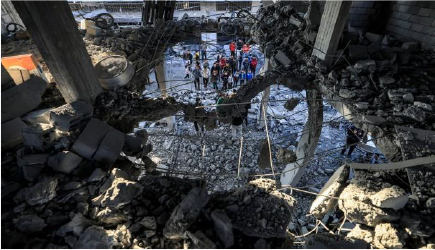



As 2024 approaches, the confluence of simmering conflicts, uncertain political tides, and fragile economies creates a perfect storm. Five geopolitical events emerge as potential turning points, capable of tipping the scales towards stability or chaos.
In the year 2024, an unprecedented number of people globally, exceeding four billion individuals in nearly eighty countries, will participate in elections. Major democracies including India, Indonesia, Pakistan, Bangladesh, Russia, Mexico, and the United States will conduct elections, and Europeans will choose representatives for the European Parliament.

Highlighting a significant event in the electoral landscape, aside from the later elections in the United States, is the pivotal ‘election of the year’ that occurred on January 13 in Taiwan. During this election, a new president, William Lai, was elected. Lai’s manifesto emphasizes endeavors to enhance the international recognition of Taiwan’s de facto independence while also underscoring the imperative to ‘substitute confrontation with dialogue.’
2024 may witness a crisis in the Taiwan Strait. Given the triumph of the faction favoring an independent Taiwan and vehemently opposing the Chinese Communist Party, anticipations of heightened aggression from Beijing loom large. Following the inauguration, one can expect various assertive actions such as naval military maneuvers, substantial airspace violations, provocative exercises – potentially involving live fire in Taiwanese waters – and anticpated cyber attacks. President Xi Jinping’s November communication to U.S. President Biden, emphasizing the imperative to “reunite” with Taiwan, triggered apprehension. Indeed, a victory by Lai could serve as a catalyst for an exaggerated response from Beijing. While a direct invasion seems improbable presently, it cannot be entirely dismissed; however, diplomatic repercussions and heightened military intimidation are highly likely.
While the Indian and Russian elections are anticipated to unfold without surprises, the U.S. elections present the “great unknown.” Though former President Trump currently holds favorability in numerous swing states, attempting to predict the outcome at this juncture is a futile endeavor. What remains certain is the looming presence of a potent, AI-enabled disinformation-heavy disruptive influence from external actors like Russia, Iran, or China. This injection of external influence is poised to further intensify the contentious nature of domestic politics. The probable result is an additional weakening of institutional structures in the United States. The president is likely to contend with a divided Congress, lacking a majority, paving the way for another period of discordant and ineffective governance.

In 2023, following the unsuccessful Ukrainian counter-offensive, the conflict entered an attritional phase. Despite Ukraine’s relative success in breaching Russia’s Black Sea blockade and targeting locations in Crimea and on Russian soil, President Putin escalated the nation’s war efforts. Military production is expanding, albeit with outdated and unsophisticated weaponry.
While both Russia and Ukraine will persist in pursuing military objectives on the battlefield, as witnessed in the past year, any decisive outcomes are unlikely. However, the war’s ultimate fate may hinge on Western election results. Owing in part to insufficient support and political deadlock from the United States and the EU, Ukraine lacked the necessary weaponry, equipment, or ammunition to breach Russia’s well-fortified defensive lines during the 2023 counter-offensive. An extraordinary shipment of artillery shells, potentially from South Korea or through a complex transfer involving Korean, US, and Ukrainian warehouses, facilitated Ukraine’s entire summer offensive. With the EU hindered by bureaucratic challenges and political impotence, Ukraine faces continued adversity throughout the remainder of this year.
Yet, even with Russian forces lacking the material superiority, morale, training, command, and offensive combat capability required for substantial gains in a counter-offensive, a noteworthy pivot occurs in the cyber domain. Russia is poised to exploit cyber warfare as a novel and pivotal frontier in the conflict. The potential for significant gains from comparatively modest investments into pro-Russian factions during upcoming elections makes cyber operations a strategic priority. Moreover, the specter of attacks on critical infrastructure are a high risk, as we have warned here.

The recent decision by the world’s shipping companies to avoid Red Sea attacks and take the longer and more costly 18th century route around Africa is just the latest reminder of the fragility of the global trading system. This theme is likely to be even more pronounced in 2024. On the one hand, the Red Sea standoff shows how much of Eurasia’s economic prosperity ultimately rests on US military power – hence the importance of crumbling Pax Americana we wrote about recently.
Yet, logistical challenges constitute just a fraction of the complexities facing global trade, set to emerge as the primary economic hurdle in the years ahead. Central to this issue is the escalating tension in the West concerning excessive investment and overproduction within the Chinese industry. As Chinese President Xi Jinping endeavors to tackle the issues of sluggish economic growth and the depletion of the nation’s current economic model, the U.S. and EU are witnessing the surge of mercantilist inclinations, erecting barriers in China’s path.
The European Commission is currently probing Chinese subsidies for electric cars, posing a significant threat to the European car industry. Potential responses from the EU include the imposition of countervailing tariffs, be they carbon or ‘green,’ or more general tariffs. Such measures wouldn’t be unwarranted given the substantial employment the car industry provides in Europe. Additionally, sectors receiving heavy Chinese investments, particularly those related to energy transit technologies, are expected to become additional sources of tension.
The inadequacy of the current World Trade Organization system, exploited by China, may lead to a resurgence of trade wars reminiscent of the tumultuous relations between the world’s two most influential countries during the Trump administration. Despite Joe Biden’s campaign criticism of these practices, his administration perpetuates them, exemplified by key legislations like the IRA or CHIPS, which are logical continuations of Trump’s direction. The potential return of Trump himself, coupled with his threats of more radical measures, including blanket and reciprocal 10% tariffs on both China and Europe, raises the specter of the collapse of the familiar global trading system of recent decades, signaling significant fractures in the international order.
Moreover, Trump has signaled an intention to diminish the U.S. role in NATO, potentially suspending the U.S. commitment under Article 5 of the North Atlantic Treaty unless European nations meet his demands for significantly higher spending on common defense. Similarly, he may explore the option of withdrawing U.S. troops from South Korea and Japan, contingent on these countries agreeing to augment funding for the stationing of U.S. forces. The prospective retreat of America from the global stage, marking a return to isolationism after nearly a century, could embolden various autocrats and revisionist forces in conflict hotspots to seek changes in the existing order. The ramifications of such conflicts would likely encompass extensive cyber fallout.

In 2024, the Chinese economy is poised to grapple with both internal and global challenges. These challenges encompass substantial over-indebtedness, lackluster domestic demand, demographic concerns, and the impact of Western strategies like “derisking” and “friendshoring.” This involves the relocation of production for certain sensitive technologies and products away from China, diminishing reliance on the Chinese supply chain, and imposing restrictions on Beijing’s access to cutting-edge technology – such as advanced chips and their manufacturing processes – as well as certain markets. Additionally, there is a growing cyber dimension to these challenges, with concerns about the potential for cyberattacks targeting China’s technological infrastructure and attempts to influence or disrupt its economic systems.
Should Beijing persist in prioritizing state-driven investments in infrastructure and manufacturing at the expense of private consumption, as recently articulated by the Politburo, prospects for improvement seem limited. The efficacy of the Chinese economic model will also hinge significantly on the fortunes of Chinese electric car manufacturers and telecommunications firms, which aspire to broaden their global exports and assert dominance in international markets, particularly within the Global South. The ongoing latent trade tensions with the West, the continual diversification of supply chains, and the increasing adoption of industrial policies in major Western economies suggest that Chinese products face a more challenging journey to global markets compared to the past. This could further aggravate domestic unemployment issues, particularly among the youth, as the private sector, closely tied to state investment incentives, struggles to generate an adequate number of jobs.
As Cyfirma has previous reported, any potential shift by the West towards a more balanced trade relationship with China, reducing overt intellectual property (IP) transfer, is likely to prompt China to intensify covert efforts in the illicit acquisition of competitor intellectual property. The primary mechanism for such endeavors would be cyber espionage. China stands out globally for its adept use of cyber attacks as a tool of statecraft, and the active involvement of the government in the economy only amplifies the inclination to employ cyber attacks for IP theft, even in non-military or dual-use contexts. Notably, China’s hacking program surpasses that of every other major nation combined. Consequently, companies operating in industries outlined in Chinese development plans will find it imperative to invest in external threat landscape management solutions to proactively counter and defend against the relentless and recurrent onslaughts by Chinese hackers.

While the Israeli military has significantly diminished Hamas’ military capabilities, it has come at the expense of substantial civilian casualties and extensive damage to Gaza’s infrastructure. This outcome is likely to force the majority of Palestinians into more dire circumstances, increasing the susceptibility to radicalization.
Gaza is expected to remain a fertile ground for organizations similar to Hamas, even if Hamas itself doesn’t endure the current conflict, which is becoming increasingly improbable. Despite sympathetic sentiments from the Arab street towards the Palestinians, neighboring states are hesitant to undertake a substantial reconstruction effort in Gaza or participate in day-to-day administration unless Israel takes concrete steps towards a two-state solution. However, achieving such a resolution seems more elusive now than it has been over the past five decades.
In addition to the physical and geopolitical challenges, the ongoing conflict also raises concerns in the cyber realm. As tensions persist, cyber activities, including attacks and disinformation campaigns, may escalate, further complicating the situation and influencing public opinion both regionally and globally.
Prime Minister Benjamin Netanyahu is facing slim chances of survival in the aftermath of a post-war inquiry into the shortcomings of his policies. Recent polls indicate that a majority of Israelis hold him responsible for the war, with only 4% of the Jewish population expressing trust in his leadership, and a considerable number calling for his resignation. However, the prevailing sentiment suggests that his potential successor is likely to be someone even more conservative from the right, rendering the prospect of a two-state solution nearly unattainable. The absence of external pressure for substantial negotiations, requiring concessions to the Palestinians, makes the resumption of serious peace talks improbable.
The current political turmoil is accompanied by cyber dynamics, with concerns rising over potential cyber activities aimed at influencing public opinion, spreading disinformation, or destabilizing key infrastructure. As the political landscape evolves, the cyber domain may become a battleground for various actors seeking to shape narratives and advance their agendas, further complicating the already intricate situation in the region.
Other Iranian proxy forces operating in the region pose a significant threat, including potential attacks on soft Western targets. Although both Iran and its non-state allies and the United States and Israel aim to avoid a major regional war, a conflict between Israel and Hamas could inadvertently trigger broader hostilities. The ongoing war serves Iran’s interests in multiple ways, temporarily halting the potential normalization of relations between Israel and its adversaries like Saudi Arabia. Additionally, it highlights the extensive reach of the “axis of resistance,” comprising Iranian-backed armed groups such as Hezbollah in Lebanon, various militias in Iraq and Syria, the Houthis in Yemen, and Palestinian militant groups like Hamas and Islamic Jihad—entities over which Tehran wields varying degrees of control.

Tehran actively embraces and supports any surge of discontent directed at Israel and the United States across the Middle East. However, the timing of the current conflict proves inconvenient for Tehran. In August, the U.S. and Iran exchanged detainees, coupled with an implicit understanding. Tehran committed to restraining Iraqi and Syrian militias from targeting U.S. forces, slowing its nuclear weapons development, and enhancing cooperation with nuclear inspectors. In return, the U.S. government was expected to ease sanctions enforcement to aid Iran’s struggling economy. This agreement, however, is now defunct.
For the United States, President Biden is averse to further Middle East conflict as he navigates challenges like supporting Ukraine, maintaining influence in Europe, and countering China in the Pacific while seeking re-election. The prior tacit agreement with Tehran aimed at deferring a nuclear or regional crisis, but the absence of formal sanctions relief for Iran led to perceptions of Washington capitulating to the ayatollahs before the U.S. election. Despite deploying significant military and diplomatic efforts to contain the conflict, Washington has yet to pressure Israel to take the crucial step that could significantly reduce the risk of war—halting the ongoing hostilities.
The Israeli-Lebanese border emerges as a potentially hazardous hotspot this year. Since October 7th, Hezbollah and Israel have engaged in escalating rocket exchanges, with Hezbollah seeking to restrain the Israeli army without crossing the threshold into full-scale warfare, as seen briefly in 2006. Despite the shared reluctance of the U.S., Israel, Iran, and Lebanon to engage in war, the situation remains precarious, particularly if the Israeli campaign in Gaza persists and Hezbollah operates with limited restraint on its home turf.
The decisions made by political leaders today and in the days to come carry profound consequences. As former U.S. Secretary of State Henry Kissinger observed, “history presents clear alternatives only in the rarest of circumstances.”